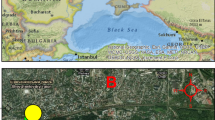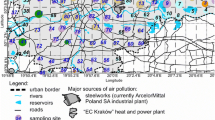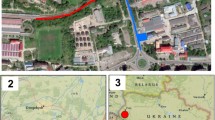Summary
Samples of metallurgical dusts and fly ashes from coal power plants and iron works in Upper Silesia as well as soil profiles in the close vicinity of these plants and in Ojcow National Park (ca. 25 km east of the industrial area) have been studied magnetically and mineralogically. The metallurgical dusts and fly ashes are highly enriched in ferromagnetic minerals. The topsoils from profiles collected near the plants have very high values of magnetic susceptibility while susceptibility in the fermentation and humic subhorizons in soil profiles from Ojcow National Park is considerably increased. The magnetic properties of the metallurgical dusts and fly ashes such as frequency dependence of susceptibility, saturation remanence or coercivity are similar to those observed in the top horizons of the soils. They are mostly related to the occurrence of large (multidomain) grains of non-stoichiometric magnetite ranging from 1 to 20 µm. The similarity of the magnetic particles in the soils is taken as evidence of an anthropogenic origin. They are responsible for the high soil susceptibilities in Upper Silesia and in adjacent areas. Some of the magnetic particles carry substantial quantitities of trace elements such as Pb, Ni, Zn and Cu. Field and laboratory susceptibility measurements can therefore be used as a simple and costeffective method of detecting the presence of heavy metals in the soils of this area.
Similar content being viewed by others
References
Beckwith P.R., Ellis J.B., Revitt D.M. and Oldfield F., 1986: Heavy metal and magnetic relationships for urban source sediments.Phys. Earth Planet. Inter. 42, 67–75.
Banerjee S.K., King J. and Marvin J., 1981: A rapid method for magnetic granulometry with applications to environmental studies.Geophys. Res. Lett. 8, 333–336.
Grodzinska K., Szarek G. and Godzik B., 1990: Heavy metal deposition in Polish National Parks — changes during ten years.Water, Air and Soil Pollution 49, 409–419.
Hansen L.D., Silberman D. and Fisher G.L., 1981: Crystalline components of stackcollected, size-fractionated coal fly ash.Environ. Sci. Technol. 15, 1057–1062.
Hullet L.D. and Weisberger A.J., 1980: Some etching studies of the microstructure and composition of large aluminosilicate particles in fly ash from coal-burning power plants.Environ. Sci. Technol. 14, 965–970.
Hullet L.D., Weisberger A.J., Northcutt K.J. and Ferguson M., 1980: Chemical species in fly ash from coal-burning power plants.Science 210, 1356–1358.
Hunt A., Jones J. and Oldfield F., 1984: Magnetic measurements and heavy metals in atmospheric particulates of anthropogenic origin.Sci. Total Environ. 33, 129–139.
Kittel C., 1949: Physical theory of ferromagnetic domains.Rev. Mod. Phys. 21, 541–583.
Maher B.A., 1986: Characterisation of soils by mineral magnetic measurements.Phys. Earth Planet. Inter. 42, 76–92.
Oldfield F., Barnosky C., Leopold E.B., and Smith J.P., 1984: Mineral magnetic studies of lake sediments.Proc. 3rd Internat. Symp. Palaeolimn. Hydrobiol. 103, 37–44.
Scoullos M., Oldfield F. and Thompson R., 1979: Magnetic monitoring of marine particulate pollution in the Elefsis Gulf, Greece.Mar. Pollut. Bull. 10, 287–291.
Stober J.C. and Thompson R., 1979: An investigation into the source of magnetic minerals in some Finnish lake sediments.Earth Planet. Sci. Lett. 45, 464–474.
Strzyszcz Z., Tolle R. and Katzur J., 1988: Zur Anwendung eines hochfrequenten Messverfahrens für den Nachweis von ferromagnetischen Eisen in der Umwelt.Arch. Ochr. Srod. 3–4, 137–143 (in German).
Strzyszcz Z., 1989a: Anwesenheit des ferromagnetischen Eisen in oberschlesischen Waldböden und deren Ursachen.Mitt. Deutsch. Bodenk. Ges. 59, 1197–1202 (in German).
Strzyszcz Z., 1989b: Ferromagnetic properties of forest soil being under influence of industrial pollution. Air pollution and forest decline.Proc. 14th Internat. Meeting for Specialists in Air Pollution Effects on Forest Ecosystems, Interlaken, UFRO P205, 201–207.
Strzyszcz Z., 1991: Ferromagnetism of soil in some Polish National Parks.Mitt. Deutsch. Bodenk. Ges. 66, 1119–1122.
Strzyszcz Z., 1993: Magnetic susceptibility of soils in the area influenced by industrial emissions. In:Soil Monitoring, Monte Verita, Birkhäuser Verlag, Basel, pp. 255–269.
Strzyszcz Z. and Magiera T., 1993: Ferromagnetycznosc gleb w Parkach Narodowych i jej wykorzystanie w monitoringu skazen ekosystemow lesnych.Pradnik. Prace Muz. Szafera. 7–8, 125–132 (in Polish).
Strzyszcz Z., Magiera T. and Bzowski Z., 1994: Magnetic susceptibility as an indicator of soils contamination in some regions of Poland.Soil Sci. Annual. Suppl. 44, 85–93.
Thompson R. and Ofdfield F., 1986:Environmental Magnetism. Allen and Unwin, London.
Author information
Authors and Affiliations
Rights and permissions
About this article
Cite this article
Strzyszcz, Z., Magiera, T. & Heller, F. The influence of industrial immissions on the magnetic susceptibility of soils in upper Silesia. Stud Geophys Geod 40, 276–286 (1996). https://doi.org/10.1007/BF02300743
Received:
Revised:
Issue Date:
DOI: https://doi.org/10.1007/BF02300743




